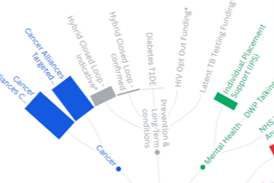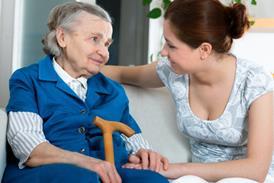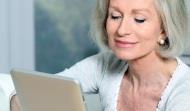Innovative ways to prevent health problems include using technology to reach out to isolated elderly people and a rethink of traditional home from hospital services
Return to the 3 Rs, main article
Return to Commissioning supplement main page
Facelook, Suffolk
We know that social isolation is a strong determinant for both mental and physical health issues and we also know that more people than ever are living alone with the national demographic changes. As people live longer this is only going to get worse.
“Supporting elderly people living alone to keep them out of hospital is a ‘must do’ and yet social care budgets have no chance of coping with this ever increasing need,” says Suffolk GP John Havard.
“Families tend to be more disparate nowadays so we need to use technology to provide some of this social interaction that we know is therapeutically beneficial.”
‘For many people it might be a choice of Facelook - or institutional care’
So earlier this year, Dr Havard developed the “Facelook” project to link vulnerable patients to a British Red Cross volunteer and family and friends through the patient’s own TV. The Transformation Fund of NHS Suffolk paid for set top boxes with webcams and four balanced microphones to provide “easy Skype” to these patients at home.
The GP practices in East Suffolk have identified patients who need support to remain at home and the BRC arranged the installation of the set-up, helped by a technology engineer from the BT Research Centre at Adastral Park.
The BRC volunteer makes face-to-face contact to get to know the patient and from then on supports them with a mixture of virtual “Facelook” visits and in-person support as needed.
The project was commissioned by NHS Ipswich and East Suffolk CCG and has yet to report on its results. “So these are my early anecdotal findings,” emphasises Dr Havard.
First of all, it is very easy to use. “Users can answer a call from their armchair or even their bed, which is a natural way for a normal welfare conversation to take place. Other benefits like witnessing correct tablets being taken and fluids being drunk are inherent in this solution,” says Dr Havard.
“Take the case of one of my elderly patients. He had got into medical problems twice already by taking his warfarin incorrectly. His daughter was keen to get involved in his care - but she lives in Australia. So now she calls at 6pm everyday to supervise him taking his medication. She is delighted that she can now play a part in her father’s care.”
Other applications are old friends who cannot get out any more but can “Facelook” each other, he adds.
“We have one disabled lady who is quite capable of managing a caseload of elderly isolated people and regularly checking they are OK - this highlights the fact that our ever-increasing elderly have the capacity to be a resource and not a burden.”
Dr Havard is looking to the future too. “With the Facelook device and broadband installed in the home then there is capacity to link in a host of other telecare products. We could, in theory, monitor movement, patterns of electricity consumption, toilet flushing and falls detectors to build up a regular daily pattern so a change could be spotted from a remote centre.”
This might sound a bit like Big Brother, he admits. “But for many people it might be a choice of Facelook - or institutional care. I can imagine patients currently needing four social care visits a day could have one of these as a virtual visit.
“We need to use technology to triage more effectively to ensure that the on-the-ground carers are directing their attention to where it is needed as well as wasting less time in their cars. And we are using University Campus Suffolk to ensure the project is structured in an academic fashion.”
Yet even with all this potential, it can be difficult to persuade patients to participate - even though they get the set-up for free.
“I have taken a tip from the door-to-door brush salesman of old,” says Dr Havard. “Their first question was never, ‘Do you want to buy a brush?’ because the answer tends to close the conversation. But ‘Do you like a clean house?’ got a foot in the door.
“So my question is ‘How would you like to see more of your family?’, rather than asking if they would like regular Red Cross volunteer contact or any of the other add-ons. Of course, once they get to know the Red Cross volunteer, they would not want to give it up for anything.”
Reablement in Camden
In Camden, north London, commissioners are keen to develop holistic approaches to care delivery - and this applies very much to reablement.
For a start, long term conditions senior commissioning manager Mousumi Basu-Doyle leads a joint team for Camden clinical commissioning group and Camden Borough Council. As she says: “You have to look at care across the patient journey from the hospital to the transfer to community and how you provide longer term support to prevent readmission.
“So is it is not just about having a reablement team but about having a responsive service that is part of a multi-disciplinary virtual team that enables timely transfer of care of clients from acute settings back home.”
The British Red Cross has been providing this reablement team-within-a-team in Camden for the last two years. Ms Basu-Doyle says they are the ideal partners because they are fast, flexible and skilled. “BRC fits very well into our model. Not all social care providers are able to provide reablement,” she says.
She explains what the volunteers do - and how it differs from the traditional home from hospital service that the Red Cross had been providing for over 10 years in Camden.
Regain confidence
“Home from hospital is a befriending, practical service, making sure there is milk in the fridge or providing companionship. Reablement is more structured involving eight home visits over a six week period that helps clients regain confidence after discharge from hospital.”
That might mean helping clients to use new equipment, or helping them access buses, claim benefits or even join a gym. “They might be raising awareness around falls prevention or helping them restart old hobbies,” adds Ms Basu-Doyle. “It’s about getting their confidence back.”
A pilot study over the last year shows that it does reduce the need for social care. Out of 364 people visited, nine in ten were contacted within 24 hours of discharge and visited within 48 hours; 60 per cent needed no further input from social services. Readmission rates were 5 per cent.
All volunteers are trained and CRB checked - Betty Constable and her colleague Joanne Yau, who are employed by the Red Cross to co-ordinate the service - make sure of that.
“We are based in St Pancras rehabilitation hospital,” explains Mrs Constable. “We get referrals from everywhere - social workers, A&E, occupational therapy, from UCL [University College Hospital London] and community services.”
A large part of the job is being ready for anything and being ready quickly. “You just never know what you are going to find,” explains Ms Constable. “One of our volunteers went to see a man and found the front door open, no food in the fridge, no electric and no key to the basement to turn it on.”
Very occasionally, she has to turn down clients where she feels there is a risk to her volunteers - whose health, safety and wellbeing she guards fiercely - for example if there are alcohol issues.
Everybody’s business
Leandra Silvestie is one of these volunteers. Aged 26 and from Brazil, he first volunteered when he was unable to get a job after finishing his university studies. A year and a half later and now in a full time job, he still volunteers because he enjoys it and can see that it works.
Often, he says, the reason stated for the referral is not the real reason people need visiting. “I have just finished working with one lady who said she needed her shopping done after being in hospital but really she was just very, very lonely. I have been helping her get out and meet people.”
Ms Basu-Doyle is now writing a prevention strategy in Camden. She wants to see training standards developed for reablement and for the reablement approach - helping people to become independent - to become the default for health and social care services.
As she says: “This is about how we support people to change their lives to be more healthy and give them the motivation, education and skills to do that. Actually this is everybody’s business.”




























No comments yet